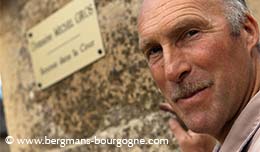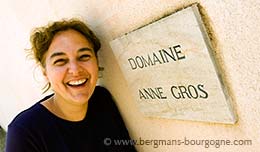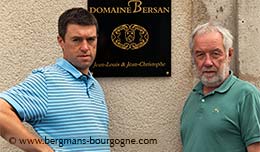
homas Pico at Domaine Pattes Loup is a firm believer in organic farming. Located in Courgis, just outside Chablis, he has been working organically in the vineyards since 2005, much thanks to his grandfather.
– Just before my grandfather died in 2004 he said to me ”Don’t make the same mistake I did”, he explains.
At the time Thomas Pico had just returned to the family domaine, Domaine de Bois d’Yver, and he was setting up his own business alongside his father’s.
– What my grandfather said had a great impact, he continues. That is the main reason why I decided to go down the organic path. My grandfather didn’t work organically, neither did my father. When I was learning the job I worked at two other Chablis domaines. I respect them a lot, but they are not organic. What really convinced me was when I began working at wine fairs and had the opportunity to taste organic wines from other producers.
 Thomas Pico decided to set up his own domaine – a separate entity, but located on the same premises as the family domaine in Courgis. Initially he took on eight hectares of vineyards from the family. Today Domaine Pattes Loup covers 15 hectares, while Domaine de Bois d’Yver has shrunk to 10 hectares.
Thomas Pico decided to set up his own domaine – a separate entity, but located on the same premises as the family domaine in Courgis. Initially he took on eight hectares of vineyards from the family. Today Domaine Pattes Loup covers 15 hectares, while Domaine de Bois d’Yver has shrunk to 10 hectares.
– When I arrived here my father had a business partner he was working with. I wanted to be able to do my thing. I wanted to be free to try different ways of working. So that’s why I created Domaine Pattes Loup.
 But Georges Pico soon followed in his son’s footsteps. In 2009 Domaine Pattes Loup was certified organic. A year later Domaine de Bois d’Yver followed.
But Georges Pico soon followed in his son’s footsteps. In 2009 Domaine Pattes Loup was certified organic. A year later Domaine de Bois d’Yver followed.
– I am still learning, says Thomas Pico. I can’t do things in a set way. When it comes to my work I still don’t have the certainty. What I am certain of though is that I want to work organically.
He prefers organic, whether it is fruit, vegetables or cheese. Organic means more taste, and that goes for wine as well, he points out.
 Thomas Pico is among the few in the Chablis area to harvest by hand. At Domaine Pattes Loup everything is harvested by hand, including the village appellation Chablis.
Thomas Pico is among the few in the Chablis area to harvest by hand. At Domaine Pattes Loup everything is harvested by hand, including the village appellation Chablis.
– It’s ridiculous, he shrugs. Only about five per cent of the growers in Chablis harvest by hand. It’s more expensive and it requires more work, but it’s a choice I have made.
The vinication process is not the same for all his wines. Thomas Pico’s three Chablis premier crus – Côte de Jouan, Beauregard and Butteaux (there is also a small amount of Vaillons from bought in grapes) – undergo both alcoholic and malolactic fermentation in barrels, whereas a large part of the village Chablis is fermented in tank.
– I like working with oak, he says. I used to be a cellarman at a négociant in the Côte d’Or for a year. The oak speaks to all your senses. You smell it, you see it, you touch it. I much more enjoy being in the barrel cellar than in the cuverie with the stainless steel tanks, even if it is more work. Being in a barrel cellar gives you more of a feeling of being a winemaker.
 Thomas Pico uses very little new oak. He buys a few new barrels each year, but the majority of the barrels in his cellar are two or three years old.
Thomas Pico uses very little new oak. He buys a few new barrels each year, but the majority of the barrels in his cellar are two or three years old.
– There are even some that are 15 years old. In the past barrels were kept for a long time. People like my grandparents didn’t have much money, so they used the barrels until they broke. Historically the material for wine is wood. Stainless steel came later. That said, I’m not a fan of wines where the impact of oak is too strong.
There are some 22-23 different parcels of village appellation Chablis at the domaine. At least 15 of these ends up in the final blend. As with all his wines, élevage is long.
 – Most of the parcels are located around Courgis, says Thomas Pico. Mainly around Butteaux, which is part of Montmains. There are some in Préhy as well, where the vines are 60 years old. The soils differs between the parcels. There are parts where the soil is a white marl and there are parts which are more stony. The oldest parcels were planted in 1951. The youngest are twelve years old, so I would guess the average age is between 20 and 30 years.
– Most of the parcels are located around Courgis, says Thomas Pico. Mainly around Butteaux, which is part of Montmains. There are some in Préhy as well, where the vines are 60 years old. The soils differs between the parcels. There are parts where the soil is a white marl and there are parts which are more stony. The oldest parcels were planted in 1951. The youngest are twelve years old, so I would guess the average age is between 20 and 30 years.
You’ll find Butteaux just north of Courgis. It is just across the border to the commune of Chablis and it is one of the premier crus which also may be labelled and sold as Montmains. Part of Thomas Pico’s Butteaux is vinified in tank, part in demi-muids, large barrels.
 – Compared with the other parts of Montmains Butteaux is a bit different, he says. The best way to experience this is to check out one of the most well-known Chablis domaines, Domaine Raveneau. They bottle the three parts separately – Butteaux, Forêts and Montmains. It is of course not only the soil that has an impact of wine. You have things like age of the vines etc, but it is an interesting comparison. I only have Butteaux. It is slightly higher in altitude and maybe a little bit later-ripening than the others.
– Compared with the other parts of Montmains Butteaux is a bit different, he says. The best way to experience this is to check out one of the most well-known Chablis domaines, Domaine Raveneau. They bottle the three parts separately – Butteaux, Forêts and Montmains. It is of course not only the soil that has an impact of wine. You have things like age of the vines etc, but it is an interesting comparison. I only have Butteaux. It is slightly higher in altitude and maybe a little bit later-ripening than the others.
Beauregard is to the immediate south of Courgis, just below the road to Chitry-le-Fort and Saint-Bris-le-Vineux.
– It’s more of white clay in Beauregard. The soil is white marl, very light in colour, and very compacted. Butteaux is much darker in colour. There you have brown clay. It’s less marly. The valley where you’ll find Butteaux is more open, which means more wind. Beauregard is in a valley which is more closed.
 Côte de Jouan is just north of the village, very close to Thomas Pico’s winery. The exposure is southeast, same as for Beauregard, and the soil is dominated by brown clay.
Côte de Jouan is just north of the village, very close to Thomas Pico’s winery. The exposure is southeast, same as for Beauregard, and the soil is dominated by brown clay.
For the 2016 vintage, with its disastrous weather conditions which cut the harvest by as much as 50 per cent, Thomas Pico looked elsewhere for grapes. A friend in Limoux, in the south of France, sold him some must, but since he chose to vinify in Courgis it could only be sold as Vin de France, which is the lowest level of three in the wine classification system of France
– It’s not a Chablis. The grapes were grown 800 kilometres from here. My friend works organically too. It’s 80 per cent chardonnay with some chenin and clairette.
He has since decided to continue with his Vin de France. The 2017 vintage will soon be bottled.
© 2018 Ola Bergman














